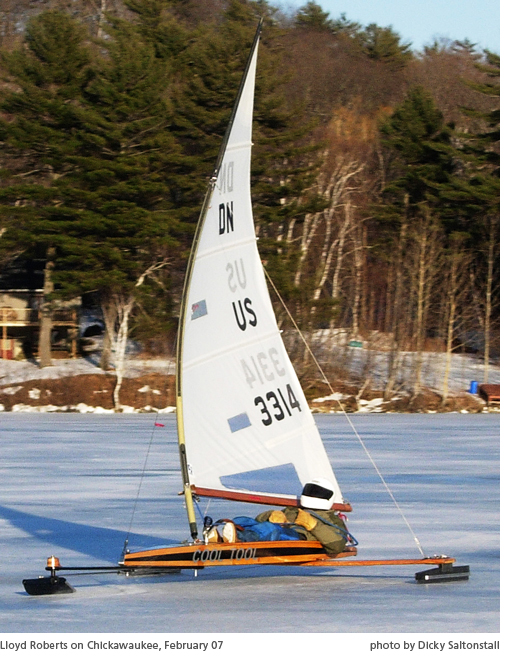
Checking the Ice
1998 reprint
from Lloyd Roberts
Is the ice safe? Maybe, how do we tell? I have been checking ice for some 20 years now. My track record is pretty good, no one has gone through ice I have checked. They have sailed into open water, but never broken through the ice.
New ice is the usual subject, whether it is the whole lake or perhaps a frozen over hole in existing ice. There are a few rules of thumb. If there are cracks in black ice it is usually strong enough to walk or skate on, 1 1/2 to 2 inches. If there are no cracks in new black ice it is pretty thin. We want at least 2 inches of cold black ice to sail on, 2 1/2 is comfortable although it may crack when stomped on. I use a light axe to test ice as I am walking or skating. If I can give it a good swat with one hand and not draw water it is just fine, black or snow ice, probably at least 4 inches. If I draw water with the sharp side I try hitting the ice with the "eye" or back side, if the eye goes through it is too thin to sail on, if the eye doesn't go through it is probably OK. I prefer skating to walking as I can cover much more ice and the skates themselves give clues. Thin ice will crack with the thrust of the skate but still hold you up and is usually getting down to the scary minimum one inch.
Glassy black ice with no cracks is bad news, you just can't tell looking at it how thick it is, cracks give you something to judge it by.
Old Spring ice and shell ice from partially frozen puddles or slush are the hardest to judge. Shell ice is very dangerous to sail on as a runner going through at speed may tear the boat apart or pitchpole it end over end, a good way to get hurt as well as break the boat. It is terribly tempting because it often is the first new surface after being snowed out for a while, don't do it. Old spring ice may seem quite solid first thing in the morning and then turn to mush in the morning sun to the point where it will not hold you. The best clue to this condition is a hollow sound of skates or runners, the ice really is hollow, just a skin of ice over waterlogged crystals, beware.
Needless to say the ice checking is safest when done by two people, both with hand picks and at least one with a throw line. I have done a lot of it solo, always with my ice picks and the axe. If the ice is thin enough to let you down, the axe could be driven through it for a good purchase. I think sailing alone to check the ice is crazy, the boat may go through before you know you are in trouble. On foot or on skates you have warning from cracking long before you are in danger of falling through.
If you do check ice, and we need those ice reports, don't just walk out 100 yards and decide it is OK. Take the time to really thoroughly check it out. If it is a big lake do the initial check on foot or skates and then get someone else and sail it. Drive by ice checks are only useful to tell us that there is or isn't ice present with or without snow cover.
If you leave a message on a hotline answering machine give the date, your name, and phone number where you can be called back. We take the ice checking very seriously and do not sail on rumors, second hand reports, or reports by non sailors. Ice fishermen are quite conservative and generally don't drill holes in ice that is too thin to sail on.
Pressure ridges and cracks can be totally unpredictable, ruining ice in a few hours. You, the skipper, are ultimately responsible for your own safety, trust the ice report enough to go to the lake, then judge for yourself, don't sail on word of mouth alone. |
